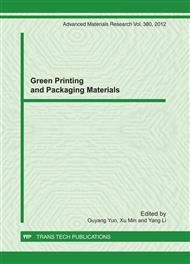p.244
p.248
p.254
p.260
p.265
p.270
p.274
p.278
p.282
Preparation of PLLA/OMMT Composite and its Properties
Abstract:
Poly(L-lactic acid ) (PLLA) /oganic montmorillonite (OMMT) composites were prepared by means of melt-mixing using a twin-screw extruder. The mechanical properties and melt flow rate of the composites were investigated, and their crystallization structure and thermal properties were characterized by X-Ray Diffraction (XRD), Differential Scanning Calorimeter (DSC), and thermogravimetric analysis (TG). It was shown that the tensile strength, elongation at break and bending strength of the PLLA/OMMT composites firstly increased and then reduced along with the increase of the content of OMMT. The melt flow rate of the composites was obviously improved and the crystallinity was increased. OMMT played a heterogeneous nucleation role in the composites, while it had little impact on thermal stability of the composites.
Info:
Periodical:
Pages:
265-269
Citation:
Online since:
November 2011
Authors:
Price:
Сopyright:
© 2012 Trans Tech Publications Ltd. All Rights Reserved
Share:
Citation:


